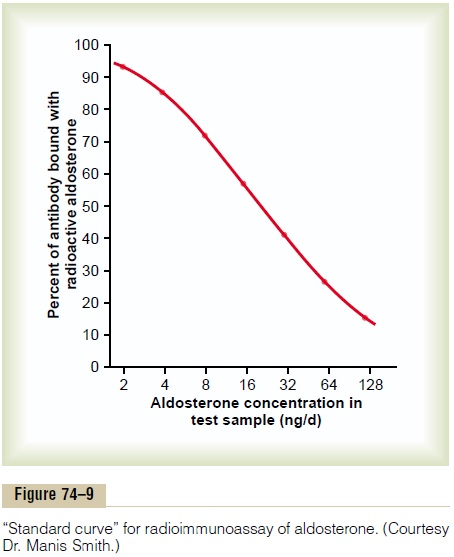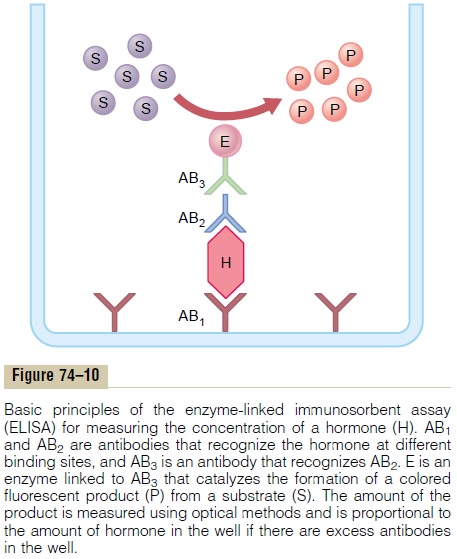Chapter: Medical Physiology: Introduction to Endocrinology
Measurement of Hormone Concentrations in the Blood
Measurement of Hormone Concentrations in the Blood
Most hormones are present in the blood in extremely minute quantities; some concentrations are as low as one billionth of a milligram (1 picogram) per milliliter. Therefore, it was very difficult to measure these con-centrations by the usual chemical means.An extremely sensitive method, however, was developed about 40 years ago that revolutionized the measurement of hor-mones, their precursors, and their metabolic end prod-ucts. This method is called radioimmunoassay.
Radioimmunoassay
The method of performing radioimmunoassay is as follows. First, an antibody that is highly specific for the hormone to be measured is produced.
Second, a small quantity of this antibody is (1) mixed with a quantity of fluid from the animal con-taining the hormone to be measured and (2) mixed simultaneously with an appropriate amount of purified standard hormone that has been tagged with a radioactive isotope. However, one specific condition must be met: There must be too little antibody to bind completely both the radioactively tagged hormone and the hormone in the fluid to be assayed. Therefore, the natural hormone in the assay fluid and the radio-active standard hormone compete for the binding sites of the antibody. In the process of competing, the quan-tity of each of the two hormones, the natural and the radioactive, that binds is proportional to its concen-tration in the assay fluid.
Third, after binding has reached equilibrium, the antibody-hormone complex is separated from the remainder of the solution, and the quantity of radio-active hormone bound in this complex is measured by radioactive counting techniques. If a large amount of radioactive hormone has bound with the antibody, it is clear that there was only a small amount of natural hormone to compete with the radioactive hormone, and therefore the concentration of the natural hormone in the assayed fluid was small. Conversely, if only a small amount of radioactive hormone has bound, it is clear that there was a large amount of natural hormone to compete for the binding sites.

Fourth, to make the assay highly quantitative, the radioimmunoassay procedure is also performed for “standard” solutions of untagged hormone at several concentration levels. Then a “standard curve” is plotted, as shown in Figure 74–9. By comparing the radioactive counts recorded from the “unknown” assay procedures with the standard curve, one can determine within an error of 10 to 15 per cent the con-centration of the hormone in the “unknown” assayed fluid. As little as billionths or even trillionths of a gram of hormone can often be assayed in this way.
Enzyme-Linked Immunosorbent Assay (ELISA)
Enzyme-linked immunosorbent assays (ELISAs) can be used to measure almost any protein, including hor-mones. This test combines the specificity of antibodies with the sensitivity of simple enzyme assays. Figure 74–10 shows the basic elements of this method, which is often performed on plastic plates that each have 96 small wells. Each well is coated with an antibody (AB1) that is specific for the hormone being assayed. Samples or standards are added to each of the wells, followed by a second antibody (AB2) that is also specific for the hormone but binds to a different site of the hormone molecule. A third antibody (AB3) is added that recog-nizes AB2 and is coupled to an enzyme that converts a suitable substrate to a product that can be easily detected by colorimetric or fluorescent optical methods.

Because each molecule of enzyme catalyzes the formation of many thousands of product molecules, even very small amounts of hormone molecules can be detected. In contrast to competitive radioimmuno-assay methods, ELISA methods use excess antib-odies so that all hormone molecules are captured in antibody-hormone complexes. Therefore, the amount of hormone present in the sample or in the standard is proportional to the amount of product formed.
The ELISA method has become widely used in clin-ical laboratories because (1) it does not employ radioactive isotopes, (2) much of the assay can be auto-mated using 96-well plates, and (3) it has proved to be a cost-effective and accurate method for assessing hormone levels.
Related Topics